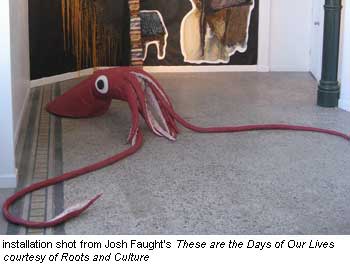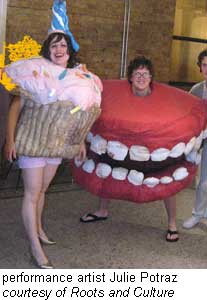Q & A
 F talks to the founder of Roots and Culture Gallery
F talks to the founder of Roots and Culture Gallery
by Natalie Edwards
above from Carrie Vinarksy's Home, and an installation shot from Loo Bain's Colossus
F Newsmagazine spoke with Eric May, founder of Roots and Culture Gallery, Reggae DJ extraordinaire, and head chef at Ox Bow. Roots and Culture is a non-profit gallery dedicated to “the nurturing of interconnectedness within the contemporary art world: it is a meeting place for arts communities both local and international.” Roots and Culture’s current show, Mr. Softy, opened March 17, and will conclude in a group show of soft sculpture and textile work, both mobile and stable, including Mike Andrews, Carrie Vinarsky, Josh Faught, Loo Bain and Kathryn Scanlan. The opening included a performance by Kansas City artist Jule Potratz, dressed as a cupcake. Roots and Culture will hold it’s first annual “Art Fair Decompression and R & C Fundraiser Party” on April 28. For ten bucks, you can support a local gallery and have a hootin’ good time.
 F Newsmagazine: How do you define activism? Is it attending a rally? Is it making art? Is it making art available to new viewers? How do you see activism merging with art? Do you expect your work to reach a wider audience, thereby becoming a form of activism? How has the relationship between activism and art changed since you have been a practicing artist?
F Newsmagazine: How do you define activism? Is it attending a rally? Is it making art? Is it making art available to new viewers? How do you see activism merging with art? Do you expect your work to reach a wider audience, thereby becoming a form of activism? How has the relationship between activism and art changed since you have been a practicing artist?
Eric May: Art’s role as a mediator of social communication can often include activist agendas. I can think of several examples of contemporary art that have become a proactive voice in a critical dialogue about social issues. For instance, Mierle Laderman Ukeles’ The Social Mirror, a New York garbage truck covered in mirrors, is a rather direct metaphor for urban blight. Chicago artist Michael Piazza and a whole score of his works dealt with a critical understanding of social justice. And there are more allegorical examples as well, such as any number of works by Felix Gonzalez-Torres dealing with the AIDS crisis, which, while not immediately confronting the viewer with a social issue, profoundly include them in a more personal and poignant reflection on loss. All of these works interest me, though I do not necessarily count myself as an authority on such concerns in contemporary art.
Actually, as a gallerist and curator, and particularly in the not-for-profit realm, I am cautious about the extent of political discussion that I include in the exhibitions. I feel that very much like the era of Piss Christ, Mapplethorpe, and the cross-dressing Harold Washington, today’s political climate with its talk of “culture wars” is one that must be approached quite gingerly as an institution seeking public funding. The question that I ask myself most frequently is, what kind of impact can my gallery, Roots and Culture, and the art that we show make on the way in which culture is experienced in a progressive and challenging way? I would not necessarily count my intentions as activism, which I think has an aggressive connotation, but rather as a catalyst for cultural understanding and awareness.
My primary mission with Roots and Culture is to provide an atmosphere that is comfortable for the audience, artists, and curators alike to really immerse themselves in the dialogue of making, sharing, and experiencing art. I feel that the established system of art commerce, like that of most experiences in this late-capitalist age, provides a very rapid cycle of commodity based decision-making. Galleries have become more like designer boutiques or showrooms rather than spaces of contemplation.
 With that said, I am all for artists making a living with their craft. I am just interested in providing a slowed down, more experiential pace at which to understand the languages of contemporary art.
With that said, I am all for artists making a living with their craft. I am just interested in providing a slowed down, more experiential pace at which to understand the languages of contemporary art.
And how do I aim to achieve these goals? Firstly, I want to make Roots and Culture accessible to artists by giving them chances to curate their own work and opportunities to curate entire exhibitions. By allowing the primary makers and authors of this language to shape the programming, it removes a more market-driven approach to what kind of work is available and allows for a more challenging and diverse art viewing experience. By removing the merchant role out of curation, the discourse is focused solely on the art experience, which should always be dictated by those with the ideas.
Empowerment of the artists builds confidence to finally exchange as a community, rather than loose acquaintances of competitive individuals. Roots and Culture hopes to inspire a resurgence of a collective experience of art making and viewing that will have a lasting and profound effect upon the way in which artists and galleries are dependent on each other.
The other pieces to offering a welcoming environment are simple—lots of smiles, a place to hang your coat, a clean bathroom, a bowl of soup, a glass of fresh squeezed juice, a beer, and a brie pesto pastry puff. This doesn’t sound that revolutionary, does it?
Click here to Tell your Friends about this page
Printer Friendly Version

 F Newsmagazine: How do you define activism? Is it attending a rally? Is it making art? Is it making art available to new viewers? How do you see activism merging with art? Do you expect your work to reach a wider audience, thereby becoming a form of activism? How has the relationship between activism and art changed since you have been a practicing artist?
F Newsmagazine: How do you define activism? Is it attending a rally? Is it making art? Is it making art available to new viewers? How do you see activism merging with art? Do you expect your work to reach a wider audience, thereby becoming a form of activism? How has the relationship between activism and art changed since you have been a practicing artist? With that said, I am all for artists making a living with their craft. I am just interested in providing a slowed down, more experiential pace at which to understand the languages of contemporary art.
With that said, I am all for artists making a living with their craft. I am just interested in providing a slowed down, more experiential pace at which to understand the languages of contemporary art.